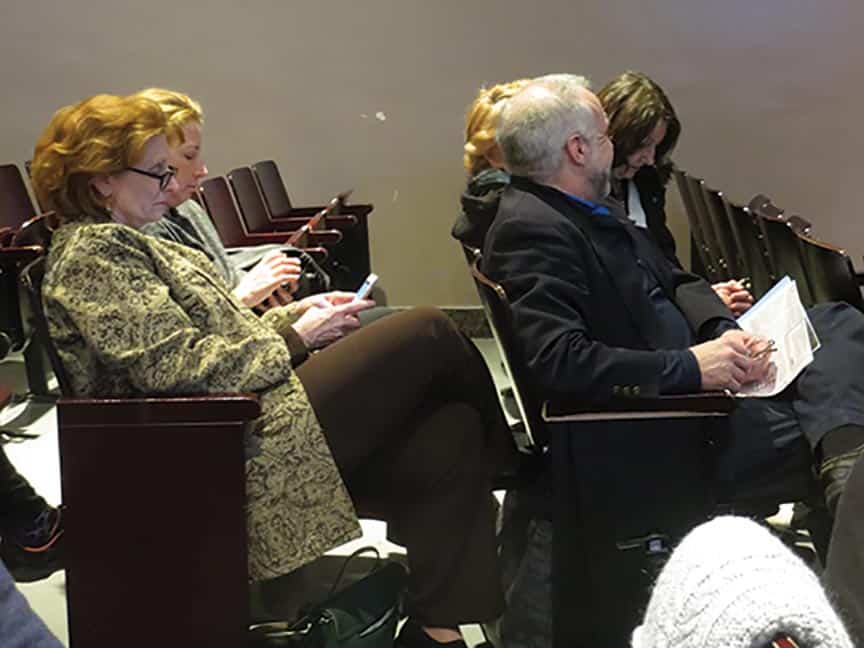On a cold wet Thursday night at the end of January, the CB6 Landmarks and Land Use Committee meeting seemed reasonably well-attended at first, about thirty-five present in a presentation space at the back of the Van Alen Institute. Most of those present, however, represented the City’s various agencies and were in attendance to support the City’s joint presentation of the Red Hook Coastal Resiliency Project, which is now open for public comment.
The Resiliency Project—a large-scale land reclamation and development project along the Red Hook waterfront—was prefaced by the more routine Committee business of approving modifications to residences in Historic Districts and, in the case of 92 King St. in Red Hook, deliberating upon a proposed exception to land use rules for the development of a vacant lot.
This last proved more contentious, and perhaps illustrated the various tensions that surround the Community Board’s relationship with a part of the District that has been gentrifying. Community mistrust of developers’ intentions and a desire to retain control over the type of development that is occurring is on one side. A developer who believes that the community board is at worst a thorn in the side of eventual approval in the convulted ULURP process is on the other side. In the middle is a community board’s limitations over the process, sometimes resulting in an escalation of tensions and community frustrations.
92 King Street was represented by attorney Chris Wright. It is a vacant lot by Coffey Park. The lot, described by Mr. Wright as an unusual lot, measures about 25 feet wide and 75 feet in length. The current owner and developer acquired the lot in July 2021, using the corporate alias Dream SDS LLC. The owner wished to develop a three-floor, single-family occupancy residence. The proposed development is constrained by current zoning that mandates five foot wide side yards, a standard front yard or parking space of 18 yards, and a back yard measuring 30 yards in depth.
The lot is in an R5 district, Mr. Wright attested, and if forced to adhere to those strict requirements, he argued, would not qualify for financing because subtracting for those requirements would leave little room for a residential development.
Mr. Wright, whose failure to provide a formal presentation became a sticking point for the Committee, noted that the City’s Board of Standards and Appeals had completed its study based on the developer’s application for an exception and found that the lot did sufficiently present a “unique physical hardship.” The exception in question is for the developer to completely eliminate the 5 ft wide yards on either side of the lot and reduce the back yard to 16 feet.
Community representatives, invited by the Land Use committee to present public comments and questions, interrogated the development and ultimately seemed to sway the Committee’s opinion on the proposal. Victoria Alexander, a community member who proved the lead critic of the developer’s request for an exception, questioned why the Committee should authorize exceptions for single-family residences when the greater and evident need is for the neighborhood to have more apartments available. Other community members pointed to the trend, along King St. in particular, of single-family homes being constructed, leading to the creation of a low-density community of higher-income residents in Red Hook. The unique nature of the neighborhood, a third critic and community member argued, is characterized by multi-family residences. Making an exception for a single-family residence, therefore, would be unwarranted, contributing to the trend of rapid gentrification.
Prior to that input, the Committee seemed more amenable to granting the exception. The developer’s representative attempted to rebut the community concerns, arguing that the proposed development would be consistent with the single-family residences on the opposite side of King St., all of which have been permitted exceptions to the side yard requirement, and that the development, being on a presently unused lot, would not displace any existing residents.
Mr. Wright, declined, however, when asked by Ms. Alexander, the vocal community member, to name the developer of the lot. The Committee, following this extended exchange between the developer’s representative and the set of community members present, moved to table the decision, requesting the representative to return with a fuller presentation and include in that drawings of the proposed development and provide evidence that this development would match the character of the existing neighborhood.
Wright left the meeting evidently disappointed, shaking his head in disbelief, evidently at the fact that the Committee had rejected what was in his considered view a most reasonable and uncomplicated request.
Community members left the meeting jubilant in contrast. The hearing on 92 King St. will resume at a later date, only the latest flashpoint in an extended struggle between actively disempowered residents, a marginally empowered Community Board, and developers with their plans for a re-imagined Red Hook.










